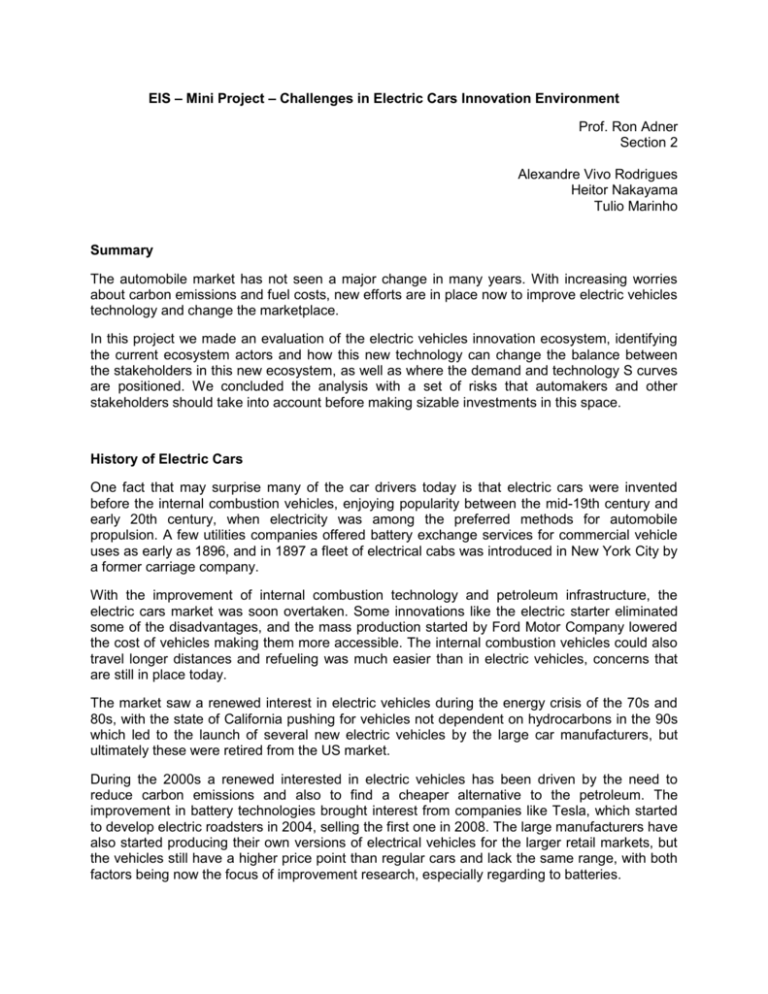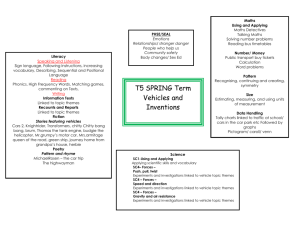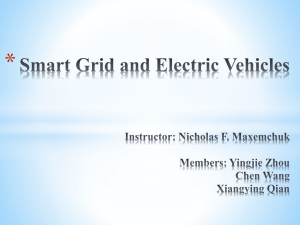Challenges_in_Electric_Cars_ARodrigues_HNakayama_TMarinho
advertisement

EIS – Mini Project – Challenges in Electric Cars Innovation Environment Prof. Ron Adner Section 2 Alexandre Vivo Rodrigues Heitor Nakayama Tulio Marinho Summary The automobile market has not seen a major change in many years. With increasing worries about carbon emissions and fuel costs, new efforts are in place now to improve electric vehicles technology and change the marketplace. In this project we made an evaluation of the electric vehicles innovation ecosystem, identifying the current ecosystem actors and how this new technology can change the balance between the stakeholders in this new ecosystem, as well as where the demand and technology S curves are positioned. We concluded the analysis with a set of risks that automakers and other stakeholders should take into account before making sizable investments in this space. History of Electric Cars One fact that may surprise many of the car drivers today is that electric cars were invented before the internal combustion vehicles, enjoying popularity between the mid-19th century and early 20th century, when electricity was among the preferred methods for automobile propulsion. A few utilities companies offered battery exchange services for commercial vehicle uses as early as 1896, and in 1897 a fleet of electrical cabs was introduced in New York City by a former carriage company. With the improvement of internal combustion technology and petroleum infrastructure, the electric cars market was soon overtaken. Some innovations like the electric starter eliminated some of the disadvantages, and the mass production started by Ford Motor Company lowered the cost of vehicles making them more accessible. The internal combustion vehicles could also travel longer distances and refueling was much easier than in electric vehicles, concerns that are still in place today. The market saw a renewed interest in electric vehicles during the energy crisis of the 70s and 80s, with the state of California pushing for vehicles not dependent on hydrocarbons in the 90s which led to the launch of several new electric vehicles by the large car manufacturers, but ultimately these were retired from the US market. During the 2000s a renewed interested in electric vehicles has been driven by the need to reduce carbon emissions and also to find a cheaper alternative to the petroleum. The improvement in battery technologies brought interest from companies like Tesla, which started to develop electric roadsters in 2004, selling the first one in 2008. The large manufacturers have also started producing their own versions of electrical vehicles for the larger retail markets, but the vehicles still have a higher price point than regular cars and lack the same range, with both factors being now the focus of improvement research, especially regarding to batteries. Innovation Drivers Explain what drives the innovation and the main interested groups in having this technology developed. The development of electric cars has two main possible goals, the creation of a vehicle with reduced or no CO2 emissions and the creation of a vehicle that has lower ownership costs. So far the main driver is still the desire to have a lower emissions vehicle, with demand mainly driven by niches of consumers seeking a green alternative for the traditional fuel car. This consumer usually is less price sensitive than the traditional one and is willing to pay a price premium to companies such as Tesla, which are specializing in producing high end electric sports cars. The main car manufacturers have also their retail electric cars, but still commanding a higher price and offering lower performance, in addition to the already widespread hybrid technology. They see the potential of this eco-conscious segment and are already buying forward positions in the segment. With increasing needs for CO2 emissions reductions, the governments may also be important drivers of this innovation, seeking to comply with international treaties and emissions quotas. They can act in the future as fomenters of this ecosystem by making use of subsidies for electric cars or even taxes for traditional ones. In addition to the governments and manufacturers, there is research going on to reduce the battery costs and improve the capacity, which is the goal of several component producers in the market. Main Ecosystem Stakeholders The innovation ecosystem for electric cars includes several players, from car manufacturers to utilities companies, including also the government. Below is a diagram with the main players and a description about each of them. Component Producers Repair Shops / Garages Vehicle Manufacturers Dealers Government Utilities Companies Consumers Consumers Consumers have the ultimate power to decide upon which technology to adopt, after all they are the ones buying the vehicles. So far the electric cars are appealing to two segments of early adopters, the ones who are green conscious and want to have the best eco-friendly technology and the ones who are cost-conscious about the running cost of their cars, but don’t necessarily care about the initial cost. The adoption of the technology by other segments of customers require further improvements on technology, specially for the ones who care about performance, and on cost, for the ones who care about the total ownership cost (which includes the initial price). Consumers also require the infra-structure to use electric vehicles, namely recharge stations. There has been some efforts to stimulate the construction of these recharge stations, with even GE financing some of them, but it is still a barrier for further development. In further sections we’ll describe how the cost and performance improvements are going to shape the adoption S curve, as well as the influence of infrastructure availability. Government Besides consumers, the government is probably one of the main actors of the ecosystem. Government is expected to have an important role on the development and mainly on the implementation of this new technology. An important responsibility of the government is to care about the overall welfare of the population and so they must develop policies concerned about fossil fuel emissions and energy security. The government is likely to interfere on this game offering subsidies, tax-benefits, and investments to incentivize the migration from the gas-fueled cars to the battery-powered vehicles. In fact, governments across many regions are starting to act in this way. Interferences of the governments can already be seen over the CO2 emissions. Many countries including the United States adopted the introduction of ethanol mixed to the regular fuel gas. Some other countries, such as Brazil, are more radical and have highly incentivized the adoption of ethanol as the single fuel. Currently, about 83% of all the new cars produced in Brazil are flex-fuel, with almost 100% of them running exclusively with ethanol. A similar approach is followed by China but already focusing in the electric engines technology. Since the cost of buying an electric vehicle is still prohibitive, China is working subsidies to help overcome the bridge and has announced that it will cover $8,800 of the cost of each electric vehicle purchased by more than a dozen of its large-city governments and taxi fleets. As soon as the electric vehicles achieve a reasonable price and mileage autonomy, the governments around the world will probably follow that trend and put a significant pressure to stimulate the adoption of this technology. Car Manufacturers Lots of speculations exist over why the car manufactures do not focus their R&Ds and invest huge sums of money on the development of an electric vehicle and abandon the investments on the development of fossil-fuel engines. However, this is exactly the critical point. Electric vehicles pose an enormous threat to the established automakers, such as Ford, GM, MercedesBenz and VW. The internal-combustion engine and the transmission are the core components they have focused on since they strategically decided to outsource the manufacture of many other components and subassemblies. A change in this core component will reshuffle all the ecosystem and the automakers will be challenged to reinvent their business if they want to survive. In the current ecosystem, the car manufacture powerhouses are the strongest stakeholders. Moreover, they are the ones with the highest probability of suffering from any change. A change in the ecosystem would reduce barriers to entry and allow other players to enter the market. One example of that is a new automaker named Tesla Motors focused on high-end sportive cars. For not being a current automaker powerhouse, Tesla can innovate much more and use that fact to take advantage and develop their technology and partnership with the battery makers. To know when will be the best time to shift their business to a new model is the great challenge for all the current largest automakers. Electric vehicles seem to be a trend that sooner or later will take off. The better understanding of the timing of that trend can define the survival on the business. Component Manufacturers Component manufactures are not really powerful on the current fossil-fuel engine ecosystem. However, they are the ones most benefited from the introduction of electric vehicles. Automakers have been outsourcing the manufacture of components other than the engine and transmission systems, but in the new setup component manufacturers are also responsible for the development of batteries and component for the electric engines. The new ecosystem creates a huge dependence of the automakers over the component manufactures. The limitation of a broad adoption of electric vehicles is partly explained by limitations on the current technology. Batteries still need to have improved their storage capacity and efficiency, and consequently the mileage autonomy of the vehicles. Another point is to figure out the best recharging system for the batteries also reducing the time necessary for a full charge. This dependence and mainly the necessity of strong and long-term partnerships with component manufactures and their R&D’s can result in a back step in which automakers start to integrate the development of the core component for their business. Dealers and Garages Although dealers are one of the most critical players in the traditional automobile distribution channel, they would very likely be indifferent to a transition to electric vehicles. For the established network of dealers that exists today, as long as the position of the traditional automakers remains unchanged in an electric world, their core competence would also remain unaltered. It is very likely that the transition to electric vehicles will not be abrupt; the dealers already have the capabilities in place to perform well in a world where the markets for electric and conventional vehicles coexist. On an individual level, the biggest risk these players face is the possibility that the automakers they represent lose market share in the electric vehicle segment. But, in reality, this is not any different from the risk they already face today of these brands losing market share in the traditional internal combustion vehicle segment. Garage and repair shops on the other hand will have to adjust to a world in which both internal combustion engines and electric motors power the cars they fix. The emerging electric vehicle segment represents a competence destroying technology to these players and a careful analysis of the costs and benefits of the adoption of this innovation by the repair industry is required. While the main peripheral systems in a car will remain unchanged, its core element – the engine – will disappear. The electric vehicle segment will require these players to invest in equipment and training to be able to serve the upcoming market. While the costs are obvious, the benefits of serving a market that hasn’t become mainstream yet may not be as clear. The automakers might find it difficult to influence these critical players to adopt the new technology early on, and this might become the source of a big risk to the new technology. Utilities Utilities represent one of the most interested parties in the mass market adoption of electric vehicles. First of all, this technology has the potential to increase electricity demand very rapidly to unseen levels and utilities will have to build up excess capacity to fulfill this increase in demand. Also, because most of the battery recharging is very likely to happen overnight, this increase in electricity consumption during off peak hours will create a much more balanced demand pattern for utilities. They face an opportunity to increase sales of electricity mostly during periods when they have the highest levels of idle capacity. In the case of mass market adoption of the electric vehicle technology, the costs that utilities will face are nothing compared the huge potential of the benefits this scenario. Co – Innovators - Charging station network One of the biggest issues facing wider acceptance of EVs is the availability of places to charge them. In general, the cars take hours to charge, so stations are needed where cars are parked. In the U.S. there are 250 million cars and only 50 million garages; this means that charging stations need to be placed in a wider variety of places such as private parking spaces for employee and customer use and on curbsides like parking meters. The problem with this approach is that it involves an unimaginable number of parties to become a widespread reality. Although the cost to create this network is very large on an aggregate level, this might be an opportunity to create a profitable model based on the individual ownership of these small stations. This risk can be much lower if the initiative to develop and market charging stations come from the utilities themselves. - Battery producers In a world where cars run on electric battery packs instead of fossil fuels, value will start shifting from oil producers to battery producers. Over the long term, the sector’s growth potential is vast, and even the near term prospects seem promising. The development of reliable technology of high density battery packs that will allow electric cars to recharge faster and offer more range without a recharge is the ultimate performance threshold that electric cars must conquer. And it seems that the technology to pass this last hurdle is improving rapidly. After the performance threshold is reached, it is only a matter of time until battery producers are able to offer their solution more cost effectively to automakers which will significantly impact the final price that buyers will have to pay for an electric vehicle. Although the future might look bright, battery manufacturers also face many challenges. As capacity ramps up, the cells of batteries (their basic element) will become a commodity, like many other automotive components. Value will migrate from the cell-level chemistry to the level of battery-pack systems, including power- and thermal-management software, and to the electronics optimizing a battery’s performance in a specific vehicle. To retain value in the longer term, battery makers may want to partner more closely with the automakers themselves. This would help battery makers preserve more value, but to succeed they would have to obtain the required systems integration skills, knowledge of cars, and key auto relationships. Considering the resources needed to achieve these goals, battery makers would have to ask themselves whether they have the engineering resources to scale the necessary capabilities across a number of vehicle platforms, model derivatives, and OEMs. Performance Technology and demand S-Curves in the industry Internal combustion vehicles Electric vehicles Demand Current stage Time Currently, the electric car technology doesn’t offer enough performance (especially range and commodity) for a competitive price to pose a threat to the traditional internal combustion engine technology. As the automakers and co-innovators in this industry further develop the technology, these issues will be resolved and in the future, electric cars will be able to offer enough range and hassle-free battery charging to compete with the established technology. Also, as the world evolves to become more environmentally conscious, there is going to be a change in the way consumers evaluate performance of their cars. Currently, there is already a strong indication that consumers are becoming more concerned about fuel efficiency and emission efficiency of their vehicles. As these features become more important, the value of emission-free vehicles (electric) will increase while fossil fuel engines will become less valuable to these customers. Conclusions According to our analysis we see a stronger convergence between the interests of the main stakeholders in the process, but there is an important set of risks that should be evaluated. Co-Innovation Risks - Battery and charging technology: the R&D efforts for performance improvement are still ongoing and there is a risk that the threshold won’t be broken in the near future; Charging Station Network: the charging performance is another issue, since it still takes some time to charge a battery in comparison with just having your gasoline tank refueled. Adoption Risks - - - - Automakers: there is a risk of not starting the adoption in the correct time, which may increase significantly the needed resources to catch up with competitors later in the process, as the learning curve may be already advanced. At the same time, over commitment at an early moment could lead to waste of valuable resources, leading to significant profit losses; Utilities: the utilities companies must adopt the technology by building a charging station network and getting ready for the capacity demands. They don’t need necessarily to build the charging points, which can be built by other interested groups, but they must get ready for the increased demand. We envision though, that building additional charging stations is in the interest of utilities companies; Government: there is a risk that governments may follow a different agenda regarding the development of electric car technology, reducing the subsidies, slowing down the adoption by other stakeholders in the market; Consumers: even though there is evidence suggesting that consumers are willing to adopt this technology at a given performance, there is a risk that they may not consider the electric car appealing to their performance needs and not willing to pay the price premium or change their lifestyle.






